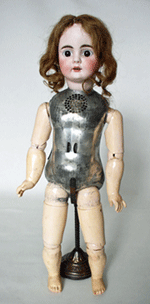In “The Sounds Around Us,” by Lawrence English, we learned about Ludwig Koch’s recording of a Common Sharma using a wax cylinder recorder. English describes this as the first “field recording” and says that it is significant in that it represents a transformation of how sound was perceived and remembered.
 Perhaps surprisingly, the first recordings made and distributed for the purposes of home entertainment were not recordings of music. Instead they were recordings of the voices of little girls reciting nursery rhymes and prayers. These recordings were then inserted into talking dolls and sold as toys. The toy was a flop and quickly disappeared from the market. The few dolls that remain in existence have been mute for some time, as their owners were reluctant to damage the wax cylinders that allowed the dolls to speak by playing them. Researchers recently developed a means for contemporary listeners to hear these voices.
Perhaps surprisingly, the first recordings made and distributed for the purposes of home entertainment were not recordings of music. Instead they were recordings of the voices of little girls reciting nursery rhymes and prayers. These recordings were then inserted into talking dolls and sold as toys. The toy was a flop and quickly disappeared from the market. The few dolls that remain in existence have been mute for some time, as their owners were reluctant to damage the wax cylinders that allowed the dolls to speak by playing them. Researchers recently developed a means for contemporary listeners to hear these voices.
When you listen, you will probably not be surprised that the toy was not successful. However, the dolls are notable in that they were the first instance in which sound recording was envisioned as a way to capture musical performances and to repeat them for entertainment purposes. In doing so, the music recording industry transformed the way in which music was experienced and created.
Read more about the talking dolls and listen to their voices in a New York Times article from May 2015.
